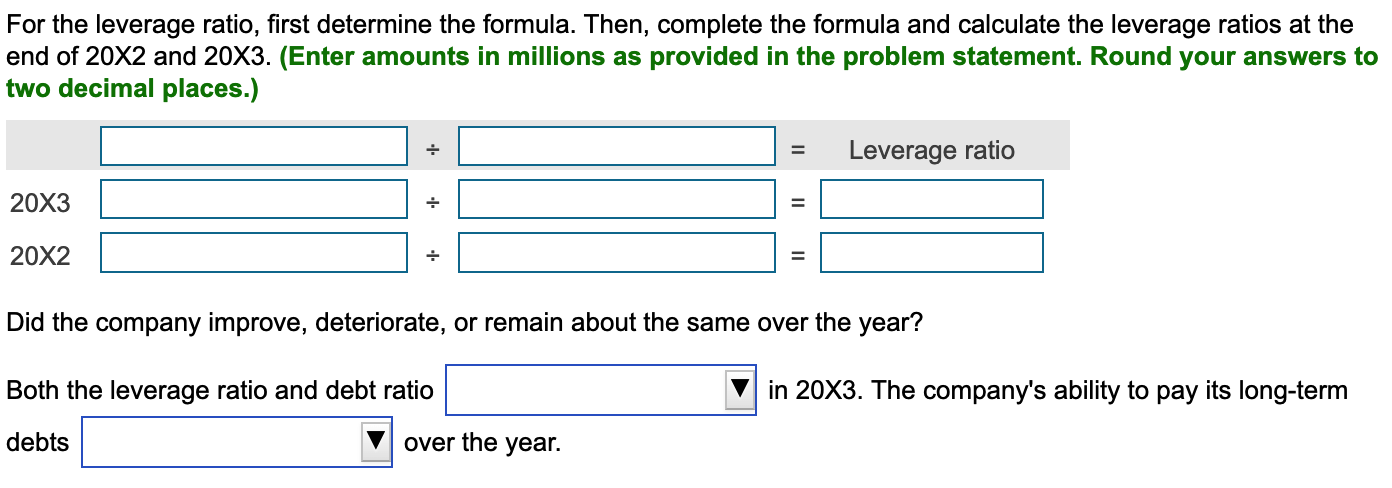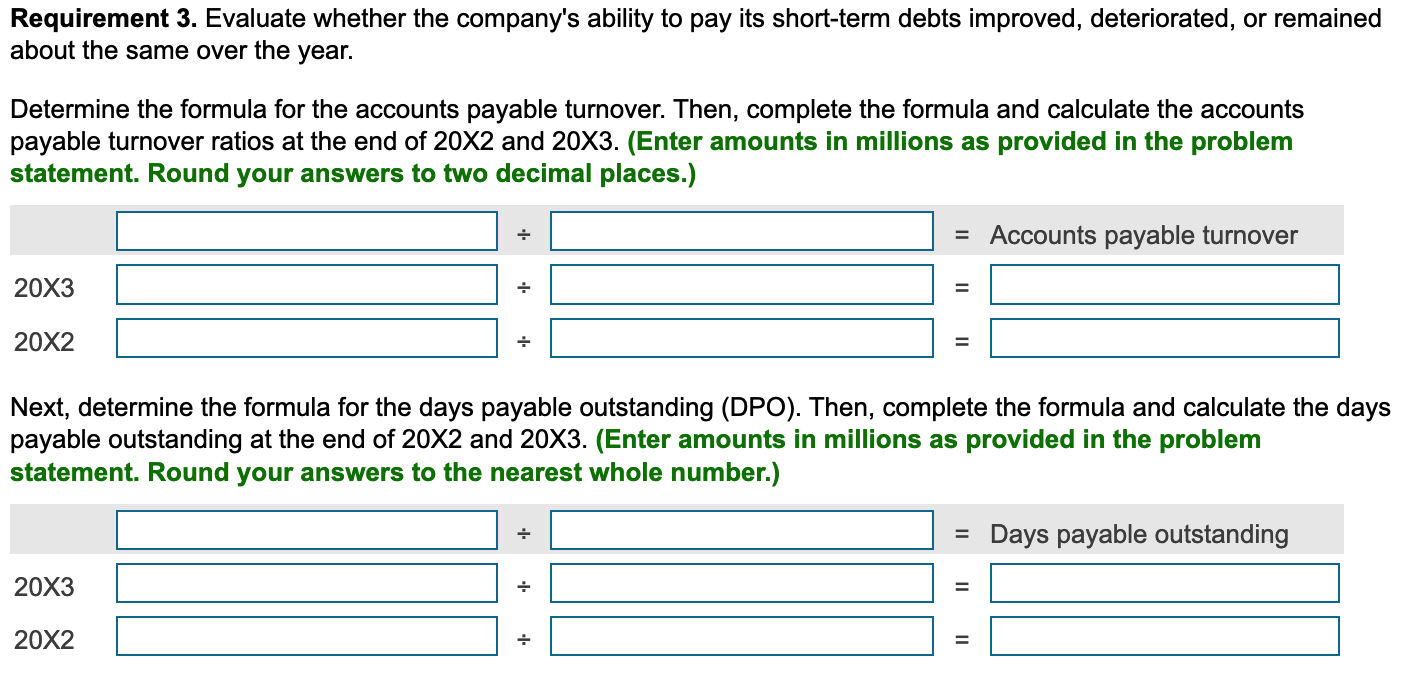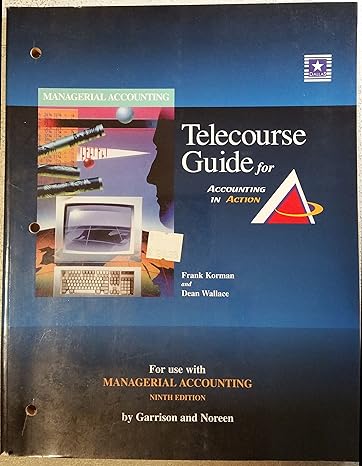Answered step by step
Verified Expert Solution
Question
1 Approved Answer
Green Homes, Inc., builds environmentally sensitive structures. The company's 20X3 revenues totalled $2,700 million. On December 31, 20X3, and 20X2, the company had $666 million







 Green Homes, Inc., builds environmentally sensitive structures. The company's 20X3 revenues totalled $2,700 million. On December 31, 20X3, and 20X2, the company had $666 million and $604 million in current assets, respectively. Accounts payable at the end of 20X1 was $193 million. The December 31,20X3, and 20X2, balance sheets and income statements reported the amount that follow. View the financial statements. Read the requirements. 1. Describe each liability of Green Homes, Inc., and state how the liability arose. 2. Evaluate whether the company's ability to pay its long-term debts improved, deteriorated, or remained about the same over the year. 3. Evaluate whether the company's ability to pay its short-term debts improved, deteriorated, or remained about the same over the year. Requirement 1. Describe each liability of Green Homes, Inc., and state how the liability arose. Choose the correct liability from the list that best fits the description provided. Amounts owed to suppliers for products or services that have been purchased on account. Expenses that the company has incurred but not yet paid; these are liabilities for expenses such as interest and income taxes. Amounts owed to employees for salaries and other payroll-related expenses. Next year's principal payment on the company's long-term debt. The amount of long-term notes and bonds payable due more than one year after the balance sheet date. The company's liabilities for providing benefits-mainly healthcare-to retirees. A catch-all group of liabilities that do not fit one of the more specific categories. These are long-term debts as shown by the fact that they are not listed among the current liabilities. Requirement 2. Evaluate whether the company's ability to pay its long-term debts improved, deteriorated, or remained about the same over the year. What were the company's total assets as of December 31, 20X3? Evaluate the company's leverage and debt ratio at the end of 20X2 and 20X3. Did the company improve, deteriorate, or remain about the same over the year? Begin by computing the debt ratios. (Round your answers to two decimal places.) What was the debt ratio for 203? What was the debt ratio for 202? For the leverage ratio, first determine the formula. Then, complete the formula and calculate the leverage ratios at the end of 20X2 and 20X3. (Enter amounts in millions as provided in the problem statement. Round your answers to two decimal places.) Did the company improve, deteriorate, or remain about the same over the year? Both the leverage ratio and debt ratio in 20X3. The company's ability to pay its long-term debts over the year. Requirement 3. Evaluate whether the company's ability to pay its short-term debts improved, deteriorated, or remained about the same over the year. Determine the formula for the accounts payable turnover. Then, complete the formula and calculate the accounts payable turnover ratios at the end of 202 and 20X3. (Enter amounts in millions as provided in the problem statement. Round your answers to two decimal places.) Next, determine the formula for the days payable outstanding (DPO). Then, complete the formula and calculate the day payable outstanding at the end of 20X2 and 20X3. (Enter amounts in millions as provided in the problem statement. Round your answers to the nearest whole number.) Now, determine the formula for the current ratio. Then, complete the formula and calculate the current ratios at the end of 20X2 and 20X3. (Round your answers to two decimal places.) Evaluate whether the company improved or deteriorated from the standpoint of ability to cover accounts payable and current liabilities. The company's ability to pay its short-term debts over the year
Green Homes, Inc., builds environmentally sensitive structures. The company's 20X3 revenues totalled $2,700 million. On December 31, 20X3, and 20X2, the company had $666 million and $604 million in current assets, respectively. Accounts payable at the end of 20X1 was $193 million. The December 31,20X3, and 20X2, balance sheets and income statements reported the amount that follow. View the financial statements. Read the requirements. 1. Describe each liability of Green Homes, Inc., and state how the liability arose. 2. Evaluate whether the company's ability to pay its long-term debts improved, deteriorated, or remained about the same over the year. 3. Evaluate whether the company's ability to pay its short-term debts improved, deteriorated, or remained about the same over the year. Requirement 1. Describe each liability of Green Homes, Inc., and state how the liability arose. Choose the correct liability from the list that best fits the description provided. Amounts owed to suppliers for products or services that have been purchased on account. Expenses that the company has incurred but not yet paid; these are liabilities for expenses such as interest and income taxes. Amounts owed to employees for salaries and other payroll-related expenses. Next year's principal payment on the company's long-term debt. The amount of long-term notes and bonds payable due more than one year after the balance sheet date. The company's liabilities for providing benefits-mainly healthcare-to retirees. A catch-all group of liabilities that do not fit one of the more specific categories. These are long-term debts as shown by the fact that they are not listed among the current liabilities. Requirement 2. Evaluate whether the company's ability to pay its long-term debts improved, deteriorated, or remained about the same over the year. What were the company's total assets as of December 31, 20X3? Evaluate the company's leverage and debt ratio at the end of 20X2 and 20X3. Did the company improve, deteriorate, or remain about the same over the year? Begin by computing the debt ratios. (Round your answers to two decimal places.) What was the debt ratio for 203? What was the debt ratio for 202? For the leverage ratio, first determine the formula. Then, complete the formula and calculate the leverage ratios at the end of 20X2 and 20X3. (Enter amounts in millions as provided in the problem statement. Round your answers to two decimal places.) Did the company improve, deteriorate, or remain about the same over the year? Both the leverage ratio and debt ratio in 20X3. The company's ability to pay its long-term debts over the year. Requirement 3. Evaluate whether the company's ability to pay its short-term debts improved, deteriorated, or remained about the same over the year. Determine the formula for the accounts payable turnover. Then, complete the formula and calculate the accounts payable turnover ratios at the end of 202 and 20X3. (Enter amounts in millions as provided in the problem statement. Round your answers to two decimal places.) Next, determine the formula for the days payable outstanding (DPO). Then, complete the formula and calculate the day payable outstanding at the end of 20X2 and 20X3. (Enter amounts in millions as provided in the problem statement. Round your answers to the nearest whole number.) Now, determine the formula for the current ratio. Then, complete the formula and calculate the current ratios at the end of 20X2 and 20X3. (Round your answers to two decimal places.) Evaluate whether the company improved or deteriorated from the standpoint of ability to cover accounts payable and current liabilities. The company's ability to pay its short-term debts over the year Step by Step Solution
There are 3 Steps involved in it
Step: 1

Get Instant Access to Expert-Tailored Solutions
See step-by-step solutions with expert insights and AI powered tools for academic success
Step: 2

Step: 3

Ace Your Homework with AI
Get the answers you need in no time with our AI-driven, step-by-step assistance
Get Started


